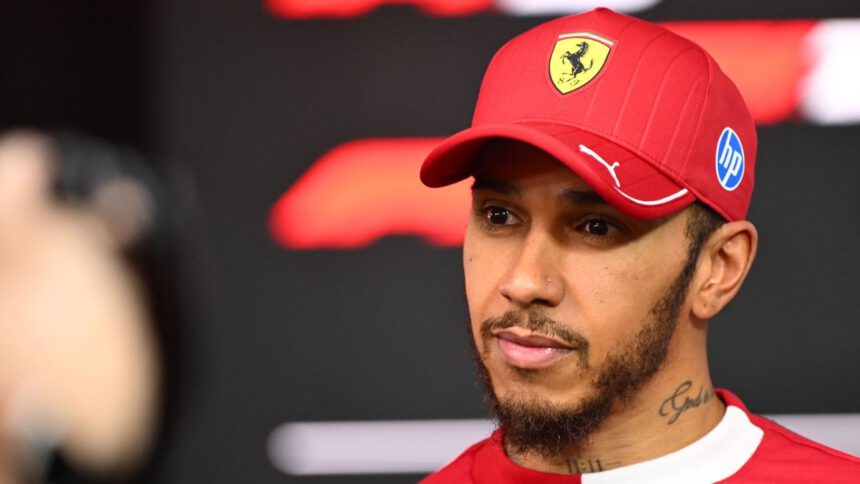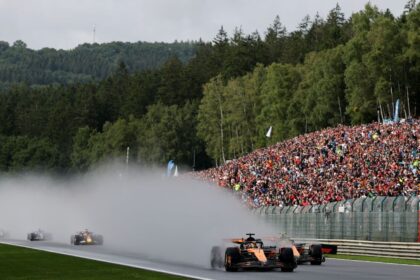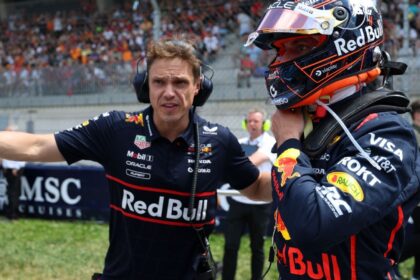Hamilton Seeks to Adapt to Ferrari After a Bitter-Sweet Weekend in Bahrain
Lewis Hamilton experienced a weekend of contrasts in the Bahrain Grand Prix, where the qualifying left him in a disappointing ninth position. Despite having achieved five victories in this circuit throughout his career, his performance in qualifying was far from expectations.
Hamilton’s fastest lap was 0.9 seconds behind Oscar Piastri’s McLaren, who took the pole position, and almost 0.6 seconds behind his Ferrari teammate, Charles Leclerc, who took second place.
This performance relegated him to ninth place on the starting grid on Sunday, and the most worrying thing was the lack of a clear explanation as to why the poor performance occurred.
“I don’t have many answers for you, I was simply not fast today,” Hamilton stated to reporters after getting out of his Ferrari.
Lewis Hamilton
When asked if this was the lowest feeling he had experienced since joining the team at the beginning of the year, Hamilton added: “It’s definitely not a good feeling, of course.”
Four Races of False Hopes
Hamilton’s first four races with Ferrari have been difficult to assess from the outside. From the moment he first drove one of the team’s cars at the private test track in Fiorano, he highlighted how different it felt compared to the Mercedes cars he had driven for the previous 12 years.
Even for a driver of Hamilton’s experience, it was clear that he would need a period of adaptation to get up to speed. Although this period did not surprise Hamilton himself, who often reiterated the great challenge he faced in changing teams at this stage of his career, it meant that he would inevitably struggle to live up to the expectations generated by his arrival at Ferrari.
A surprising pole position and victory in the sprint race in China provided the team and the driver with a tangible result after a disappointing debut in Australia. However, the sprint race in China proved to be an anomaly in Hamilton’s form at the beginning of the season, and his inability to replicate that kind of performance, even in the Chinese Grand Prix, has only underlined the difficulty of the task.
At the end of the third race in Japan, Hamilton felt he had made progress and, even more promisingly, said that the team had found something in his car that would give him a tenth of a second in lap time relative to Leclerc. Considering that the average difference between teammates in the first four qualifying sessions of the season (Australia, China sprint, China and Japan) had been 0.048 seconds in favor of Leclerc, this had the potential to change things for Hamilton in Bahrain.
According to all reports, the mysterious difference between the cars was corrected for Bahrain, but that only made the reality of the qualifying session even more brutal for Hamilton.
In Q1 he was marginally faster than Leclerc, in Q2 he was 0.285 seconds slower than his teammate and in Q3, when it really mattered, he was 0.597 seconds off his teammate, a bigger difference than at any other point this year. It didn’t help that Hamilton’s first lap in Q3 was deleted for a track limits violation at Turn 13, but it was of little relevance to the final result, as his first attempt was substantially slower than the second.
Although Hamilton couldn’t explain the deficit to Leclerc after the session, his telemetry provided some answers. In the first six corners of the lap, he matched his teammate, before losing a fraction of a second in Turn 7 and then over 0.2 seconds in the low-speed Turn 8.
Leclerc carried 4 km/h more speed in Turn 8 and again in Turn 10, resulting in a lap time advantage of 0.3 seconds over Hamilton on the back straight towards Turn 11. Then he was 10 km/h faster than Hamilton in Turn 11 and 12 km/h faster in Turn 13, resulting in another 0.25 seconds in Leclerc’s favor.
Perhaps most worrying of all for Hamilton was that there were no lock-ups or understeer to explain the 0.55 seconds lost in those four corners: he was simply lacking pace compared to Leclerc.

Mark Sutton – Formula 1/Formula 1 via Getty Images
What Was Behind Hamilton’s Change on Race Day?
However, on Sunday evening, Hamilton’s weekend story took a more positive turn. He went from ninth on the grid to fifth at the finish, and halfway through the second stint seemed to have some kind of epiphany in the car.
Ferrari opted for an alternative strategy to the rest of the top ten in Bahrain, starting both cars on medium tires, while the rest started on the soft compound, which meant they could run longer in the race before making their first pit stops. Both cars were called to the pits on lap 18, with Hamilton dropping to eleventh place, while Leclerc, who started the race in second place, remained in the fight for the podium in fourth place.
On his second lap on the track after the pit stop, Hamilton set the fastest lap of the race up to that point, and in the following eight laps, he overtook five cars to move up to sixth place. As a measure of the pace he was able to find in his second stint, Hamilton had a deficit of 16.7 seconds to George Russell in second place when he rejoined after his pit stop, which had been reduced to 11.3 seconds when the race was neutralized with a safety car on lap 32. It is true that Russell’s tires were four laps older than Hamilton’s during that 14-lap period of the race, but Hamilton overtook five cars by position, while Russell had relatively clean air in second place.
Compared to Leclerc over the same 14-lap period, Hamilton only lost 0.6 seconds of race time despite his overtaking exploits. Moreover, once he overtook Esteban Ocon for sixth place on lap 24, he reduced the gap to Leclerc by 1.5 seconds in the following eight laps.
Although these comparisons are limited to a snapshot of 14 laps of a 57-lap race, Hamilton’s pace during that phase coincided with a much better feeling inside the car, and a sense of optimism for the upcoming races.
“It was much more positive,” he said on Sunday night. “The stint in the middle was really… I felt really aligned with the car, the balance was finally in a good place and my driving style seemed to be working at that point. So I learned a lot from today, and from this weekend actually, a lot, probably more than all the other weekends.”
Lewis Hamilton
He added: “The qualifying isn’t good enough, but I think if I can get the car like that intermediate stint, and start performing the two of us, then you can see that I can still race. So if I fix that, it should be a better weekend.”
Hamilton has never shied away from the need to change his driving style to adapt to the Ferrari, but knowing exactly what to change has not been a simple process. In the last race in Japan, he revealed that he and Leclerc had diverged on setup options over the weekend, but in Bahrain Hamilton decided to get closer to Leclerc.
It was then, during the second stint of the race, when he seemed to unlock a better understanding of how to access more performance from that setup, especially in braking, and it was those laps before the safety car that provided a path of hope for the seven-time world champion heading into the next race in Saudi Arabia.
“I think what’s clear is that, as humans, we get very stuck in our ways,” Hamilton said after the race. “And I think I’ve been driving a certain way and in a certain way with the same team for so long, and now I’ve moved to a new car and a new team and it requires such a different driving style and setup.”
Lewis Hamilton
“I’ve been using engine braking [with Ferrari], which we never used [at Mercedes], and very different brakes. We are with Brembos and I’ve been with Cis [Carbon Industrie] for the last 15 years or so. This car simply requires a very different driving style. I’ve been adapting to that and I think I’ve been slowly getting it into my head.”
“Getting the right balance, what is clear is that Charles starts with a setup and sticks with it all weekend, and I was very far from him last weekend and at the beginning of this weekend. Just before qualifying I got closer to him, but all the setups are wrong and I haven’t… so I have to do a better job over the weekend. I know I can, and I will.”

Ayman Yaqoob/Anadolu via Getty Images
Team principal Frédéric Vasseur acknowledges the challenge Hamilton faces in adapting from Mercedes to Ferrari, but says he encourages a bit of introspection from the 40-year-old driver when he fails to match Leclerc.
“You’re not going to replace 12 years of collaboration [with Mercedes] in two weeks or in two races [with Ferrari],” said Vasseur. “That means that, of course, we need to improve [with Hamilton], but I think this is true for everyone in the team, in the paddock: the DNA of the whole sport is to try to do a better job.”
Frédéric Vasseur
“I think it’s good to have Lewis with this mentality to say: ‘Okay, I also have to improve and adapt to the car.’ We will work on the car to adapt it to Lewis, but he also has to take a step.”
“I think that this, between us, is done in a positive and very constructive way. Now, the fact that last night he was a little depressed, I like. Because if the guy comes back in 10th place and just says ‘It’s a shame’, that’s not enough. Surely he was disappointed by the classification because he was much better all weekend until now.”
After the false dawn of the Chinese sprint race, expectations of a sudden performance increase are likely to be kept in check ahead of Saudi Arabia, but by moving to a setup closer to Leclerc’s and understanding how to exploit it better, Hamilton should be in a better position to move forward.
“I just need to make it easier for myself, I’m doing everything the hard way at the moment,” he said. “I’ll try next week to start in a better place and not deviate too much from that. As I said, I think I’ve figured out how the car likes to be driven, so hopefully if I can apply that next week, if I can qualify better, I can have a much better weekend.”
Lewis Hamilton










